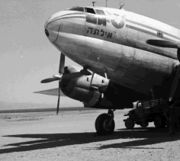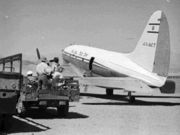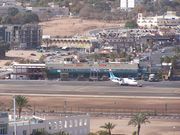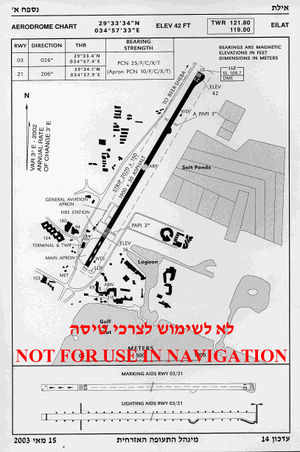Eilat Airport
| Eilat Airport (J. Hozman Airport) נמל התעופה אילת مطار إيلات |
|||
|---|---|---|---|
| Eilat Airport | |||
| IATA: ETH – ICAO: LLET | |||
| Summary | |||
| Airport type | Public | ||
| Operator | Israel Airports Authority | ||
| Serves | Eilat, Israel | ||
| Location | Eilat, Israel | ||
| Elevation AMSL | 42 ft / 13 m | ||
| Website | |||
| Runways | |||
| Direction | Length | Surface | |
| ft | m | ||
| 03/21 | 6,234 | 1,900 | Asphalt |
| Statistics (2005) | |||
| Total Passengers | 1,048,975 | ||
| Total Operations | 18,777 | ||
Eilat Airport (Hebrew: נמל התעופה אילת, Namal HaTe'ufa Eilat, Arabic: مطار إيلات), also known as J. Hozman Airport (IATA: ETH, ICAO: LLET), is an Israeli airport located in the city of Eilat. It mostly handles domestic flights to Tel Aviv and Haifa with international flights going to Ovda International Airport, but a few international flights on aircraft that can handle the relatively short runway use Eilat as well. Eilat Airport is located in the central area of the city, next to Route 90 (The Arava Road). The airport is expected to cease civilian operations by 2010 when Eilat's new international airport should become operational.[1] The airport is a focus city for Arkia Israel Airlines and Israir Airlines.
Contents |
History



Eilat Airport was established in 1949 by the Israel Air Force, following the 1948 Israeli War of Independence. During its early years, the airport aimed to establish a comprehensive set of connections to towns across the country, most notably with Tel Aviv and Haifa. Consequently, a regular route from Eilat to Lod Airport (now Ben Gurion International Airport) was started. It was not much longer before a route to Haifa Airport became operational. In December 1950, following their establishment, Arkia Israel Airlines became the largest domestic operator at Eilat Airport, taking the position of the former companies Eilata and Aviron. To this day, they retain this position. Later, in 1964 the runway was expanded to 1500 m, and a passenger terminal was built. Five years later, the runway was further expanded increasing the length to 1900 m. In 1975, Eilat Airport started to attract Scandinavian airlines. The first international flight arrival to Eilat, of the Danish airline, Sterling Airlines landed in this year. Since then, many international routes have been established directly linking Eilat with Europe, however, the airport is still unable to handle landings of large aircraft which have to fly to Ovda International Airport.[2]
In the 1994 Peace Agreement between Israel and Jordan it was decided that operations were supposed to be transferred from Eilat Airport to Aqaba Airport. The original plan was to rename Aqaba Airport as Aqaba-Eilat Peace International Airport.[3] The agreement was never followed, however, and an agreement between the two countries in March 1997, stipulated that domestic flights would continue to use Eilat Airport, whilst no further action to move international flights took place.[4] In August 2005, a Katyusha rocket fired from Jordan landed near a taxi traveling just 15 yards (14 m) from the airport perimeter fence.[5]
The airport today
|

Today, Eilat Airport sustains peak loads concentrated into Thursdays, Saturdays, and Sundays. On Thursdays and Sundays, flights are handled in a period of a few hours in the mornings and on Saturdays only the evening hours are used. Often there are days when 10,000 passengers on 120 flights are channelled through the 2,800 m2 terminal, counting as one of the highest peak loads worldwide in this category.[8]
Although the airport is capable of handling Boeing 767 aircraft, for large numbers of these aircraft, significant investment would be needed. Consequentially, the largest aircraft regularly flying to the airport are Boeing 757.[8] The main problem at the airport is the lack of ramp space, with just two parking positions for large aircraft.[8] As a result, El Al operates regular shuttle flights from Ben Gurion International Airport carrying passengers from around the world on 757's, 737's and ATR's.[8]
The small size of the airport is perhaps best illustrated with the fact that a Boeing 757 cannot taxi past another aircraft to parking positions.[8] As a result, controllers are responsible not only for ensuring that valuable space is utilised, but also ensuring that other aircraft are kept circling until larger aircraft are parked.[8] Despite these limitations, the airport successfully handles ten to twenty times more traffic than airports of a comparable size.[8] It is for this reason that plans to relocate the airport are so important in the short-term scale. In 2006, a NIS 5.5 million renovation programme of Eilat Airport's terminal and runway was undertaken, designed to sustain the airport until it is replaced in the near future.[9]
The future
Since the beginning of the 1990s the authorities in Eilat have considered relocating the airport, approximately 20 km north of Eilat, to the Ora Well area near Be'er Ora.[10] There were numerous reasons behind this idea. Primarily, the fact that safety would be improved as in its current location, there is the chance of aircraft crashing into buildings in the city.[8] Other reasons were the pure value of the land which the airport occupies, and the fact that the airport is dividing the city of Eilat into two parts with the hotels and tourist areas on one side, and the residential buildings on the other.[8]
Airlines and destinations
| Airlines | Destinations |
|---|---|
| Arkia Israel Airlines | Haifa, Tel Aviv-Ben Gurion, Tel Aviv-Sde Dov |
| El Al | Paris-Charles de Gaulle, Tel Aviv-Ben Gurion |
| israir | Haifa, Tel Aviv-Ben Gurion, Tel Aviv-Sde Dov |
| Sun D'Or International Airlines | London-Luton (Charter) |
See also
- Eilat
- Ovda International Airport
References
- ↑ "Eilat's new International Airport On Its Way". IAA. http://www.iaa.gov.il/Rashat/en-US/Rashot/MessagesArchive/SpokesMan/Spokesman_En_200206.htm. Retrieved 2007-05-01.
- ↑ "History". IAA. http://www.iaa.gov.il/Rashat/en-US/Airports/Eilat/AbouttheAirport/History/. Retrieved 2007-07-21.
- ↑ "Jordan, Israel agree to construction of Aqaba-Eilat airport <accessdate=2007-05-05". http://www.jordanembassyus.org/070899004.htm.
- ↑ "Eilat to maintain internal flight service.". Israel Business Today. 2007-03-15. http://www.highbeam.com/doc/1G1-19260212.html. Retrieved 2007-05-31.
- ↑ "Six Suspects Sought in Jordan Missile Attack". http://www.foxnews.com/story/0,2933,166190,00.html. Retrieved 2007-05-05.
- ↑ "Eilat Airport". AZ World Airport. Archived from the original on September 30, 2007. http://web.archive.org/web/20070930023935/http://www.azworldairports.com/cfm/frame.cfm?src=http://www.azworldairports.com/airports/p2720mme.htm. Retrieved 2007-07-21.
- ↑ "Eilat Airport Statistics". IAA. http://www.iaa.gov.il/Rashat/en-US/Airports/Eilat/AbouttheAirport/Statistics/. Retrieved 2007-07-21.
- ↑ 8.0 8.1 8.2 8.3 8.4 8.5 8.6 8.7 8.8 "Israel's Holiday Airport Eilat". Flug Revue. http://www.flug-revue.rotor.com/frheft/FRH0309/FR0309f.htm. Retrieved 2007-05-01.
- ↑ Avi Krawitz (2006-07-03). "Eilat Airport completes NIS 5.5m. upgrade". Jerusalem Post. http://www.highbeam.com/doc/1P1-125986904.html. Retrieved 2007-05-31.
- ↑ "Eilat Airport". ICEN. 1991-04-26. http://www.accessmylibrary.com/premium/0286/0286-9231906.html. Retrieved 2007-07-21.
External links
- Eilat Airport (English)
- Eilat at Airports Worldwide
- Aerial view of Eilat and the airport
- Airport information for LLET at World Aero Data. Data current as of October 2006.Source: DAFIF.
- Airport information for ETH / LLET at Great Circle Mapper. Source: DAFIF (effective Oct. 2006).
- Current weather for LLET at NOAA/NWS
- Accident history for ETH / LLET at Aviation Safety Network
|
|||||||||||
|
|||||||||||||||||